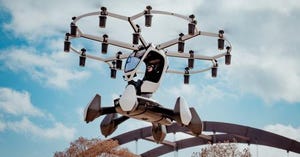Picking the right IoT protocol may mean everything to your business’s IoT project.
January 28, 2019

By Brad Bush
It’s been more than 30 years since the first unofficial Internet of Things (IoT) device — a Carnegie Mellon soda machine in 1982, modified to report its beverage stock to a group of university students who wanted to avoid cold, caffeine-driven treks only to find it empty. Decades later, the IoT has yet to emerge from its infancy and realize its potential on the large scale we’ve been expecting. But that’s about to change.
Over the past 10 years, IoT technologies have become more affordable and effective. Devices themselves are less expensive, more power efficient, smaller and increasingly optimized to fill specific roles within IoT architectures to create new business outcomes. In the next 20 years, we could connect as many as a trillion devices to the internet. The more devices we connect, the more business improvement opportunities we’ll be able to uncover and implement with IoT.
Now that the requisite technologies are nearing maturity, functional IoT implementations are ramping up. A tide of IoT services and systems have begun to hit the market, replete with varied architectures, feature sets and applications. While there are many factors to consider when investing in IoT hardware or a full IoT solution, understanding the protocols available for IoT sensors, and how forward-thinking business decision-makers can make the best choice of protocol, now and for the long term, is paramount.
How to Select an IoT Protocol
An IoT protocol is the network language that the nodes of an IoT system speak, and is central to the overall viability of a deployment. The protocol dictates the range, format, and complexity of the IoT solution’s communications, and plays a chief role in determining cost and features.
So, if you’re interested in deploying your own IoT, how do you select the right protocol — one that fits your needs and scale? There are two primary continuums to consider:
Power. Do sensors need to stay in the field for days, months or years on battery power? How often will they need to report? Are disposable devices being considered, or will replaceable or rechargeable batteries be used?
Connectivity. What range must communications cover, and how much data will they need to send in each message? Will cell providers be able to maintain your connectivity, or will you prefer to keep up your own network and the data that runs over your network?
Where an IoT deployments’ needs fall along these continuums will usually indicate which protocols they should consider and what costs to expect. The smallest and least-demanding IoT setups — for connected homes or offices — can run on ordinary Wi-Fi networks, with all components continuously powered. Other choices for close-in connection are Zigbee, Z-Wave and Bluetooth.
Each has a distinct mixture of strengths and weaknesses when it comes to power, range and cost.
For larger areas like farms, campuses or cities, where small-volume data transmissions are needed, self-contained low-power wide-area networks (LPWANs) are the perfect answer — LoRaWAN and SigFox are the two most popular LPWANs. When talking about covering regional areas and across boundaries, a cellular protocol like NB-IoT or Cat-M may look increasingly practical.
Let’s examine the specific use cases for LPWANs, along with cellular IoT deployments, to help understand which option will provide future IoT benefits and growth.
Run an Optimized Area Network with an LPWAN
If you manage a large-scale undertaking like a construction project, an oil-refinery turnaround, or any similar operation where people, equipment and dangerous conditions need to be tracked across an expansive site, you may have thought about launching your own IoT deployment. Maybe you run a factory or warehouse; maybe you’re responsible for overseeing a ranch or other agricultural tract; maybe you maintain a large school or government campus. All of these are industries where IoT seems poised to make lasting business impacts — creating more efficient processes, saving money and creating new revenue. For networks that connect an area larger than a single small building, LPWANs usually make the most sense.
If you deploy an LPWAN like LoRaWAN as opposed to connecting to cellular IoT, you will most likely pay the same or less and you will own more elements in your deployment. While cost-benefit models will vary depending on your business model, LPWANs will generally give you a private area network for your desired coverage area: you own all the devices, the network and the data that goes over the network. When cellular networks go down, or towers fail, you don’t have to worry about your IoT deployment failing, and you don’t have to wait for your provider to fix it.
If you install your own LPWAN, then you’re responsible for monitoring, support, maintenance and repairs when things go wrong. You also will have to determine how you will secure your network. For these reasons, it’s highly recommended that you deploy an LPWAN that includes the whole solution packaged together. This means the sensors, gateways, cloud and applications created by one company rather than assembled piecemeal. The advantage is that everything will be pre-integrated and designed to work securely together, and you’ll always know who to call when you need support and maintenance.
Another notable difference is that, unlike cellular data-packets, LPWAN transmissions don’t always wait on reception confirmation. This can be a benefit and a liability: you are able to get more traffic on the system without acknowledgments, but there are times you’ll lose data-points due to network congestion.
The two most popular LPWAN protocols are LoRaWAN and SigFox. Of the two, LoRaWAN and LoRa technology have shown the most growth over recent years, as well as growth-potential over the next five years. That’s not to discount SigFox, which is up and running largely in Europe, and requires less power per device than LoRaWAN. SigFox operates on smaller data payloads than LoRaWAN, making the lower power drain possible, but also restricting SigFox users from some of the industries and key features LoRa technology offers, like support of actuators and in-field updates.
The simple case for LoRa and LoRaWAN is their widespread support, versatility and outlook. More than 500 leading technology companies have joined the LoRa Alliance. LoRa technologies are continuously evolving to meet changing IoT methodologies and new use cases.
Harness Long-Distance IoT with a Cellular Protocol
Imagine you’re responsible for supplying citywide or statewide hospitals, retailers, airports or other businesses, and can profit from a consistent clear view of your shipments. Or imagine you’re involved in disaster preparedness or environmental monitoring and need to analyze info from a region-spanning net of sensors and data sources. Maybe you run a rental business and could use a way to keep closer track of your equipment and vehicles across an unpredictably vast space. In these use cases and more, cellular IoT can be a gamechanger, rounding up data from far-flung endpoints. Cellular protocols will lead the IoT discussion for those operating on a wide scale, or in areas they can’t legally or logistically erect gateways.
While it’s possible other technologies will arise and claim a share of the still-developing market, the two protocols that seem to be garnishing the most market share and discussion are Cat-M and NB-IoT.
Of the two, Narrowband IoT (NB-IoT) is more battery efficient and likely available at a lower subscription price. It offers low-power communications and data size that match the LoRa profile more closely, making cross-sensor compatibility simpler for IoT providers wanting to cover both LPWAN and cellular use cases.
Conversely, Cat-M will allow for higher data rates and low-latency communications, which could be crucial if the user needs to collect large files from his or her IoT devices or push large updates down the pipe to IoT endpoints. Cat-M will allow for low-quality voice and will be used more in true real-time applications like smart vehicles.
Cellular IoT protocols provide a means of harnessing IoT data on a regional, country-wide or even transcontinental scale without the need for pre-established gateways to create a coverage area. Instead, the provider’s already existent cell towers will transport the IoT data. This also means that your IoT will have the same blind spots the cellular networks do, and if the network connection is interrupted — for maintenance, subscription-limits, emergencies or some other reason — your IoT will also go down. Still, ease of deployment and the coverage area often overweigh the costs and limitations of dependence on a cellular provider.
Looking Forward
It remains to be seen exactly how pervasive NB-IoT and Cat-M protocols will be. Rollouts for both are relatively recent and growing, and the availability of both will largely depend on cellular providers plans. Ultimately, the low-power communications of NB-IoT will provide the right benefit at the right cost for most, and it will eventually dwarf other cellular protocols. However, there will still be a place for LPWAN and LoRaWAN, specifically for companies that want to cover large areas or have private networks.
Perhaps we’ll see more IoT companies moving to a protocol-agnostic model, where you won’t need to select for a certain protocol in order to choose which IoT solution to deploy. Your sensors could support multi-protocol. As you look at deploying IoT in the present with an eye on future compatibility, be aware which protocols you can consider, and choose one that makes sense for your scale, your power and connectivity needs, and the future of the technology.
Brad Bush is managing director, IoT for Longview. He has more than 25 years of technical and leadership experience, serving in roles as CIO, COO and CMO for high-growth, technology-based companies. He was named a WebRTC pioneer, an InformationWeek CIO top innovator and a top 50 CMO in telecom. He holds a bachelor of science in civil engineering from Rice University and an MBA from Southern Methodist University.
You May Also Like
.jpeg?width=700&auto=webp&quality=80&disable=upscale)
.png?width=700&auto=webp&quality=80&disable=upscale)



.png?width=300&auto=webp&quality=80&disable=upscale)
